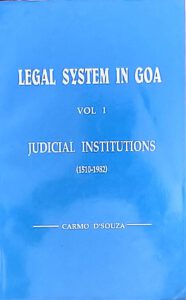
Legal System in Goa, Vol. 1, Judicial Institutions (1510-1982), by Carmo Souza, [Self-published, 1995], pp. 189, Rs 150
With the debate on the Uniform Civil Code picking up in the country, the history of the legal system in Goa can well be expected to come into focus very soon. Our Civil Code, framed by the Portuguese and still in force, as well as the judicial system developed by them, had been the object of praise for the then chief justice of India, Y. B. Chandrachud, when he opened the Goa bench of the Bombay High Court in Pangim, in 1982.
Carmo Souza’s book on the legal system in Goa is a welcome addition to literature on the subject hitherto found only in Portuguese. Originally his doctoral thesis submitted at the University of Poona, this academic presentation traces the developmental history of the judicial system in Goa from 1510 to 1982. Logically, this should have been preceded by a study of the legislation and legislative institutions of the corresponding period, in an independent volume. But this will hopefully come as a sequel.
The present volume assumes importance for several reasons. The Portuguese were the first colonial power to set foot and control a vast Oriental empire. Once Goa became their headquarters of the empire, the Tribunal da Relação, or High Court, established in the old city of Goa in 1544, administered justice at the appeal level to all the Portuguese possessions and settlements from the Cape of Good Hope to the China Seas. With them was formed the modern concept of international law in trade, commerce, and navigation.
In the introductory chapter, the author refers to old and modern judicial institutions in Portugal and compares them with those set up in the Estado da Índia. Chapter 2 gives a brief idea of the pre-Portuguese judicial system in Goa, including the Comunidades, and goes on to discuss twenty major offices and institutions that administered justice sectionally, “taking into consideration the different interests and pressures arising in the cosmopolitan society created by a maritime empire.” That list includes, among others, the Tribunal da Relação (treated in detail in chapter 3) and the Holy Tribunal of the Inquisition which, the author says, quoting a contemporary (ex-) Jesuit historian, had “apparently won the confidence of the natives.”
Chapter 4 dwells on the tumultuous period from 1800 to 1961, marked as it was by the advent of constitutionalism in Portugal. A new process began with the decree of 1832/36. Goa saw the addition of the New Conquests, wherein the indigenous system of judicial administration continued. Uniform dispensation of justice came only towards the end of the nineteenth century.
“Post-Liberation Judiciary” makes up the final chapter. This treats the dismantling of “a vibrant system”. Problems encountered in the transition phase are brought out. Interviews with judges and lawyers of the erstwhile regime, if included here, might have thrown more light on the topic.
Souza attempts to provide insight into whether certain institutions under the civil law system may be used in the Anglo-Indian system and the possibility of creating healthy hybrid institutions. He mentions the possibility of Goa having a High Court of its own.
Legal system in Goa is not critical as to advance any value judgements. This does not, however, detract from the rich documental value and the pioneering effort at systematization undertaken by Carmo Souza of a much neglected body of knowledge. His work could well serve as a background for the studies of judicial institutions of erstwhile Portuguese colonies in Asia, Africa and South America too.
(Herald – The Illustrated Review, 15-30 June 1995. A shorter version of this review, titled ‘Fresh Legal Insight’, appeared in ‘Panorama’, The Navhind Times, 1 Oct 1995)